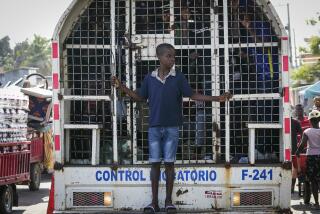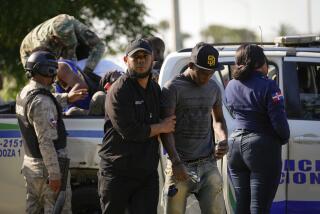Aging Leaderâs Public Works Projects Spur Economy : Boom Times for Dominican Republic
SANTO DOMINGO, Dominican Republic â To his admirers there is a poignant symbolism in the blind old leaderâs most visible building project, a towering modern lighthouse shaped like a leaning crucifix.
The 11-story, $20-million structure will project a high-tech cross of light 8,000 feet into the air, marking the site of the tomb of Christopher Columbus in its massive base and serving as a monument, when it opens in 1992, to the 500th anniversary of the discovery of the Americas.
But to President Joaquin Balaguerâs critics, the lighthouse is another Cheopsâ Pyramid, costly testimony to a vain political leader who reckons his influence over the Dominican Republic to be eternal.
Just six weeks away from his 81st birthday and determined to hang on to life and the presidency at least until the quincentenary, the pragmatic Balaguer shares neither view.
The monumental lighthouse and dozens of other public building projects begun since the frail, five-time president regained office two years ago âare necessary because they reduce unemployment in our country.â Added Balaguer in a recent interview: â . . . They are important works because they have important social goals.â
His multibillion-dollar public works program encompasses thousands of housing units, roads, tunnels, aqueducts, a hydroelectric dam, irrigation canals and the restoration of the ancient colonial center of the capital, Santo Domingo, as well as the Columbus lighthouse. And while many quibble over projects like the lighthouse, everyone agrees that the building spree has achieved its employment goal.
âThere are 120,000 people working who otherwise would be out of a job,â said Balaguerâs special assistant, Juan Jose Arteaga.
On the surface, it looks as if the extraordinarily energetic octogenarian has brought off an economic miracle in the small Caribbean country of 6.7 million that shares the island of Hispaniola with Haiti.
Surging Tourism
Tourism has rocketed in just a few years to outpace the Dominican Republicâs traditional mainstays of sugar, coffee and cocoa as the leading source of foreign exchange, about $600 million last year. By the end of this year, the Dominican Republic will lead the Caribbean, including Puerto Rico, in the number of hotel beds available--16,000.
Bargain-hungry travelers find the languid tropical shorelines and their growing numbers of Las Vegas-style hotels almost unbelievably cheap. Some United States and Canadian tour operators offer an all-inclusive week of sun, sand and casino night life here for less than $500, including air fare.
Lured by 60-cent-an-hour wages, U.S. and multinational companies are clamoring for space to put assembly plants in the countryâs rapidly expanding number of industrial free-trade zones. Four years ago, 20,000 Dominicans, mostly women, worked in a handful of free-trade zone industrial parks assembling such things as medical equipment, garments and electronic gadgets from parts and pieces imported without tax or red tape and exported duty free with as little fuss.
Today, more than 70,000 are at work in 15 free-trade zones, drawing $140 million in rents and wages to the local economy. Half a dozen more zones are under construction.
In the hard-pressed agricultural sector, still staggering from the collapse of world sugar prices and an 80% cut in American sugar quotas, there are few signs of boom times. But economists see hope in the redeployment of old sugar cane fields to a growing pineapple crop that experts say bears fruit almost as good as Hawaiiâs. Dole, with a $15-million investment, already has begun to export the new crop.
Even baseball has joined the growth spree. The Dominican Republic has long been a rich source of talent, with about 300 Dominicans now playing for North American major and minor league teams.
Twenty-one of the 26 big league teams have opened baseball âacademiesâ here, and they employ more than 100 full-time scouts and thousands of âbird dogsâ to scour the country for kids anxious to play their way to fame and wealth.
Dodgersâ School
The Los Angeles Dodgers opened the most elaborate of the schools last year at a reported cost of $1 million. Not far from the capital, it is a 30-acre former cane field now gracefully landscaped to include two regulation diamonds, a professional quality clubhouse, a dining hall and dormitories for 40 full-time aspirants.
âThe backbone of the Dodger farm system is now Dominican,â said Rafael Avila, the 58-year-old Cuban-born former ballplayer who manages the Dodger school, noting that, after only one year, he has been forced to expand dining and living facilities to keep up with the flow of rookies.
In addition to the boom enjoyed in many sectors of the local economy, about a million Dominicans who live abroad--most in the United States--send home between $500 million and $1 billion a year.
Yet, despite the seeming economic miracle, Dominicans are unhappy--and for good reason. Foreign debt hovers at about $4 billion. The purchasing power of the Dominican peso has been more than halved in the past 18 months. Inflation, about 35% last year, is currently running at 60%.
Government price controls on basic foodstuffs have driven milk, salt, eggs and chicken from store shelves. Bakers went on strike in the spring when the government raised the cost of flour but not the controlled price of bread. Last February and March, thousands poured into the streets of towns throughout the country to protest inflation and food shortages.
At least once a day, sometimes all day, the capitalâs 1.5 million residents must do without electricity, a chronic problem throughout the country. Acknowledging there was no quick fix in sight, the government last year began permitting Dominicans to import small gasoline-powered generators duty free.
âItâs a very poorly managed economy,â complained Rafael Herrera, chief editor of Listin Diario, the countryâs top newspaper.
âBalaguer is a man of another time, and his ideas are a half-century old,â said Eduardo Latorre, an economist who directs a private foundation in Santo Domingo. âPublic sector investment is almost entirely responsible for the economic growth weâve seen here, and it is almost entirely in construction.â
Latorre said the lighthouse was an old idea of the Dominican dictator, Gen. Rafael Trujillo, who shelved it as too expensive years before he was assassinated in 1961. Balaguer, a historian, lawyer, poet and political moderate, served briefly as token president under Trujillo before the assassination, then was elected to the presidency for three successive terms between 1966 and 1978. Although he engaged in a massive building program during those years, the lighthouse project was not revived until his current term began.
âWith 1992 coming closer, he decided to do something like the Pyramid of Cheops,â said Latorre about the lighthouse, noting the aging presidentâs lifelong absorption in the history of the Spanish in the New World. âIt weighs heavy on him, that sense of history, that sense of eternity.â
More to Read
Sign up for Essential California
The most important California stories and recommendations in your inbox every morning.
You may occasionally receive promotional content from the Los Angeles Times.










